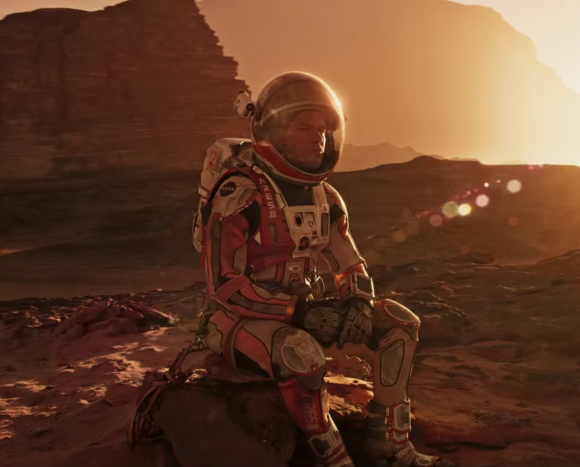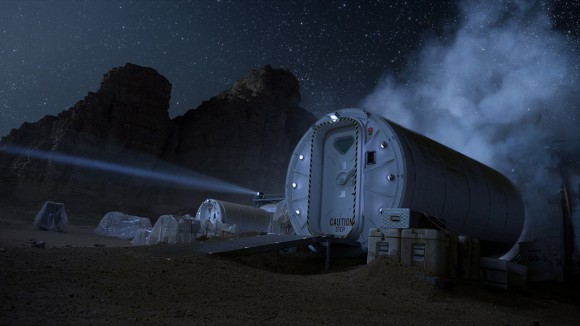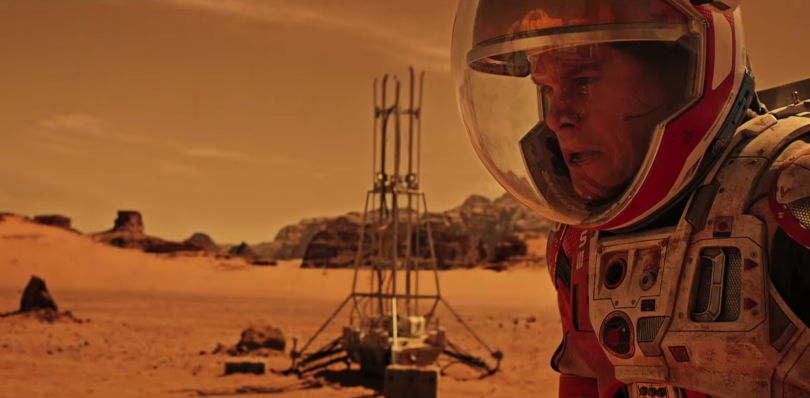 aNewDomain — “Just when I thought I was out they pull me back in,” said Michael Corleone in “The Godfather: Part III.” That’s how I feel about space. I’ve covered it more times than I can count. But these days I’ve been paying more attention to Virgin Galactic making space travel possible than NASA.
aNewDomain — “Just when I thought I was out they pull me back in,” said Michael Corleone in “The Godfather: Part III.” That’s how I feel about space. I’ve covered it more times than I can count. But these days I’ve been paying more attention to Virgin Galactic making space travel possible than NASA.
Until they showed us pictures of Pluto. And found sound in space, and took those ultra-high res Blue Marble shots. Oh yeah — they discovered water on Mars, too. All this brings me to “The Martian” — the perfectly timed blockbuster that makes space and NASA cool all over again. Even exploring Mars now seems possible and hip.
“The Martian”
In the film, the NASA Ares 3 crew, commanded by Captain Melissa Lewis (played by Jessica Chastain), is on a lengthy mission to Mars that gets shut down early due to a storm that will destroy their ship if they don’t leave immediately. Martian storms make our hurricanes and tornadoes seem as innocuous as a spring shower.
As the crew is making a hasty retreat back to their spaceship, Matt Damon’s character, Mark Watney, gets injured. Lewis wants to save him but is convinced by the crew that he must be left behind. He’s dead anyway; they all saw him get impaled by an antenna.
 But it turns out he isn’t dead.
But it turns out he isn’t dead.
And we have to accept the freak circumstances that lead to his survival or the movie would be over. If the astronaut was Joe Pesci or Steve Buscemi, I would have had trouble buying Watney’s survival. But it’s Matt Damon, the actor who survived several Jason Bourne movies, so I’m in. And you will be, too.
Sean Bean plays NASA scientist Mitch Henderson, who helps figure out a way to rescue Watney with Dr. Vincent Kapoor (played by Chiwetel Ejiofor), the head of Mars missions for NASA. Jeff Daniels is spot on as Teddy Sanders, the head of NASA and a “play-it-safe suit,” who is reluctant to even let Lewis and the crew know that Watney is still alive on Mars. All the people on Earth learn Watney is alive ahead of the Ares crew, which sadly seems 100 percent believable.
A Space Revival
The stellar ensemble cast and epic storyline of “The Martian” make NASA cool again. What’s more, in “The Martian,” botany is the bomb, and space gardens are possible.
Matt Damon’s character, Mark Watney, makes farming sexy. Instead of the usual ex-test-pilot astronaut (like so many other space explorers in real life and the movies), Damon is a nerdy botanist. And, despite the abundance of ready-to-eat meals left over by a mission cut short, Watney figures out quickly that he needs to grow his own food to survive. Suddenly raising potatoes on a lifeless planet is not just sexy — it’s necessary. (Damon frequently appears shirtless due to the heat of his makeshift hothouse. I started to get a bit steamy just watching the buff 45-year-old actor.) Farming, in fact, seemed so sexy that I have added Iowa farms to my list of must-visit places in America.
Other notable cast members include Kristin Wiig (playing a jumpy PR person named Annie Montrose), Michael Pena (as astronaut and Watney buddy, Rick Martinez) and Donald Glover (portraying math genius, Rich Purnell, who comes up with the formula that can save Watney and makes math one of the film’s heroes).
NASA technology shown in “The Martian” that really does exist
Every good science movie (or book) starts a debate about what is actually “possible.” Sure, you need to take a leap of faith to believe every aspect of “The Martian,” but there is some stunning technology in the movie that totally exists in real life. Here are five of them.
1. Human habitat: Pictured below is the “Hab,” which makes human habitat on Mars possible in “The Martian.” The image below is The Human Exploration Research Analog (HERA), a real training center in NASA’s Johnson Space Center.


NASA says of HERA:
HERA is a self-contained environment that simulates a deep-space habit. The two-story habitat is complete with living quarters, workspaces, a hygiene module and a simulated airlock. Within the module, test subjects conduct operational tasks, complete payload objectives and live together for 14 days (soon planned to increase to up to 60 days), simulating future missions in the isolated environment. Astronauts have recently used the facility to simulate ISS missions. These research analogs provide valuable data in human factors, behavioral health and countermeasures to help further NASA’s understanding on how to conduct deep space operations.”
2. Space Farming: The International Space Station (ISS) receives its primary food supplies via cargo supply vehicles. But that wouldn’t be possible on Mars, because even if UPS or Federal Express were to offer a Mars route, the quickest Big Brown or FedEx could get there would be nine months. So, to sustain life on Mars, farming would be necessary.
Although Damon’s character manages to grow some potatoes, today, the most plentiful crop in space is lettuce. The deployable plant growing system on the ISS is called Veggie, and it was created by ORBITEC, a technology corporation based in Wisconsin.
Before Veg 1 was deployed on the ISS in May 2014, it was tested at NASA’s Kennedy Space Center in Florida. Veggie plants grow in “pillows” that are small bags containing seeds, calcined clay (the same stuff used on baseball fields) and a time-released fertilizer. While astronauts grew “Outredgeous” red romaine lettuce in Veg 1 on the ISS, a control group of red leaf lettuce was grown at the Kennedy Space Center.
In August, astronauts on the ISS sampled their space-grown red leaf lettuce crop for the first time. This is a huge step in space botany and also has applications for farming here at home. NASA wants to expand the amount and type of crops it can grow to accommodate the nutritional needs of astronauts on Mars when we finally (yes, really) get there.

3. Water recovery: The Ares 3 crew had been very resourceful about reclaiming water, but Watney (Damon) has to become even more creative about staying hydrated.
On the ISS, the Environmental Control and Life Support System recovers and recycles water from everything, including hand washing, oral hygiene and urine. Its Water Recovery System (WRS) reclaims and filters water to make it ready to be swallowed (or perhaps re-swallowed). NASA anonymously quotes an astronaut as saying: “Yesterday’s coffee turns into tomorrow’s coffee.” (Gee, that might make Folger’s rethink it’s “Folger’s crystals” in your cup slogan.)
In a microgravity environment, liquids behave differently, so the part of the WRS that processes urine uses a centrifuge for distillation, because gases and liquids do not separate like they do on Earth.
NASA is developing a variety of new water recovery technologies. For journeys to distant planets, human crews would have to be less dependent on any resupply of water or spare parts from Mother Earth.
Check out Astronaut Reid Wiseman’s #SpaceVine selfie of himself through a water droplet on the ISS.
4. Oxygen: Something we can take for granted on Earth is oxygen. We would be able to leave home on Earth without our American Express card, but we sure as hell will need oxygen. In the movie, Watney uses a system in his Hab that distills oxygen from carbon dioxide generated by the Mars Ascent Vehicle fuel generator.
Astronauts and cosmonauts on the ISS have the Oxygen Generation System, which reprocesses the spacecraft’s atmosphere to continuously and sustainably provide breathable air as efficiently as possible. It uses electrolysis to separate water molecules into oxygen and hydrogen. The oxygen is released into the space station’s atmosphere, while the hydrogen is discarded into space or fed into the Sabatier System, which creates water from remaining byproducts in the ISS atmosphere.
With an eye toward Mars, NASA has partnered with other companies to recover even more oxygen from byproducts in the atmosphere.
5. Mars Spacesuit: On Mars, Mark Watney spends a lot of time outside in his spacesuit. Watney’s suit appears to be a bit more flexible and comfortable than NASA’s current prototypes, the Z-2 Prototype eXploration Suit. The Z-2 is being designed with Mars in mind so that astronauts can spend time comfortably outside, where they will need to be able to pick up rocks and deal with dust. Since we don’t know how Mars’ red soil might affect systems inside a spaceship, spacesuits are being designed so that the suit can stay outside.
“The Martian” has revived my affection for NASA and space exploration in a way that “Gravity,” with its overall bleaker tone, did not.
In 1969, I remember Neil Armstrong saying “That’s one small step for man, one giant leap for mankind.” I believe I watched the moonwalk on TV at home that night. But I also remember it was a big deal at school and that we may have had a special assembly to talk about it. I was 10 years old and — to be honest — episodes of the original “Star Trek” are a bit fresher in my mind than that moonwalk.
Thanks, Matt Damon, Ridley Scott (director), Drew Goddard (screenplay) Andy Weir and the entire cast for making NASA cool again.
Here’s the official trailer for “The Martian.”
Video: The Martian | Official Trailer [HD] | 20th Century FOX
If you think you may be ready to sign up with NASA or the European Space Agency, check out what European Space Agency Astronaut Andreas Morgensen had to say about re-experiencing gravity following his mid-September return to Earth from the International Space Station.
Video: Interview with Andreas after landing
For aNewDomain, I’m Terry Gardner.
Images in order: Damon on Mars screenshot courtesy Official Trailer 20th Century FOX, All Rights Reserved; Damon on sitting screenshot courtesy Official Trailer 20th Century FOX, All Rights Reserved; Mars habitat image courtesy 20th Century FOX, All Rights Reserved; HERA image via NASA; ISS image via NASA.













